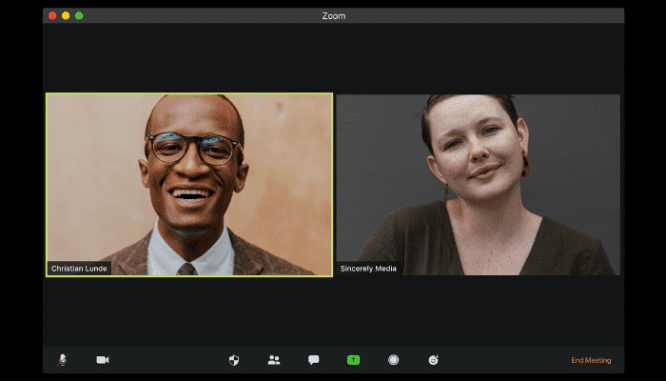How to Tour a House Remotely: A Guide for Homebuyers
- Published on
- 4 min read
-
 Kim Dinan Contributing AuthorClose
Kim Dinan Contributing AuthorClose Kim Dinan Contributing Author
Kim Dinan Contributing AuthorKim Dinan is a writer, journalist and author. She's the outdoor news editor at Blue Ridge Outdoors and writes regularly for her local paper in Asheville, NC, covering everything from the necessity of home inspections to trends in the local economy. Kim is also the author of "The Yellow Envelope," a memoir about the time she sold her house and traveled around the globe.
You’ve done your research online and found what looks like the perfect home. You’d love to go take a look, but due to circumstances (you live out of town or, ahem, there’s a global pandemic), you aren’t able to tour the home in person.
When you can’t walk through a house yourself, the next best thing is a remote home tour conducted by someone you trust, like your real estate agent. If you must buy a house remotely, this could be one of the only ways for you to tour the home before you buy.
Here’s what you need to know about touring a home remotely.

How a remote home tour works
To take part in a remote home tour, all you need is an agent local to the area where you would like to buy and the ability to communicate through an online platform.
To enable you to see the home, your agent will walk through the house for you with a cell phone, using FaceTime, Zoom, Skype, or another video chat service, showing you the house one-on-one. The National Association of Realtors says that software like Immoviewer, which offers video tours, and BombBomb, which offers video check-ins, are also becoming popular options for remote home tours.
As you remotely tour the home, you’ll be able to ask your agent questions, and your agent will be your eyes and ears, checking all the nooks and crannies of the home so you can gather the information you need to decide whether you want to move forward with a purchase.
Work with a qualified agent
Because you won’t be able to tour the home in person, it’s extremely important to have an agent you trust — and whose opinion you value. It’s also a great idea to work with an agent who knows the area where you want to move intimately because an agent with in-depth knowledge of the area will know certain things about the neighborhood you won’t be able to gather during a remote home tour, like if the home is in a noisy flight path or located near a busy road.
Before you settle on an agent, you’ll want to make sure that they have a strong idea of what you’re looking for in a home. Has your agent listened closely enough to know that having a fenced-in yard for your dog is much more important to you than having a second full bath, for example?
“I do a detailed needs analysis with all of my buyers, whether they are buying remotely or not,” says Linda Devlin, a top real estate agent in Pittsburgh, Pennsylvania.
“When your agent does an analysis upfront, she can dial in on the parameters that are important to you and make the best use of everyone’s time.”
Your agent will be your boots on the ground, helping you figure out which home is right for you, and that means they need to be dedicated to finding the perfect fit.
Research homes in advance
When you’re ready to begin your online home search, your agent will get you access to the Multiple Listing Service (MLS), which has all the most up-to-date information about homes currently for sale. “We send virtual buyers the portal ahead of time so they can review the property,” explains Mike Sobh, an experienced real estate agent in Wayne County, Michigan.
As you review the MLS, look carefully at listings. You’ll want to read the descriptions, study all the photos and videos, familiarize yourself with the home’s features and attributes, and ask your agent to pull comparable listings (comps) for the homes you like best so you can get a sense of what they are selling for right now.
Once you’ve decided on one or more homes to tour remotely, get your hands on the floor plans, if possible; they’ll help you navigate these remote tours more effectively. “The biggest thing about virtually touring a home is to do your homework on the property,” says Sobh.
Devlin says she likes to make sure her clients are prepared by sending them all the disclosures that are available for the property. “That way buyers are armed with information about important aspects of the property, like the kind of heating and cooling system it has.”

Attend a virtual open house if you can
Before you decide to have your agent walk through the home while virtually showing it to you, see if you can first attend the home’s virtual open house. Listing agents will sometimes offer this service, and it can give you the opportunity to walk through a house remotely.
This won’t be the same as a remote home tour; you’ll be part of an audience with other buyers instead of one-on-one — but it’s still a great chance to get a peek at the home and see if you want to pursue it further.
If you can’t catch the live virtual open house, see if it’s recorded and posted online, such as on the listing agent’s Facebook page (often, they’re recorded as Facebook Live events that can be viewed later) or directly on the MLS listing.
While you attend the virtual open house, pay attention and take notes so you can talk to your agent about whether the house is a good fit for you.
Schedule your remote home tour
If you like the house and want to learn more, schedule a remote home tour with your agent. “If a client is interested in a specific property, we will then set up a virtual tour through an online platform like Facetime, Zoom, or even Facebook Messenger,” says Sobh. Devlin adds that the platform through which you participate in the virtual home tour is “the client’s choice.”
Typically, your agent will be the one walking you through the house — and ideally, they won’t be accompanied by anybody else, including the seller or listing agent, just like if you were attending the home tour in person.
And just like an in-person tour, the same rules apply during a remote home tour: show up on time so you’re not wasting the agent’s or seller’s time — or yours.

Pay close attention
Your agent can give you more details about the house, but this is one of your best opportunities to learn everything you can about the home. During your virtual tour, ask your agent to open cabinets and drawers, give you feedback on whether the floors squeak, how it smells, and whether you can hear street noise from inside the house.
“I make sure to point out all the little things that are wrong, so when they have their inspection, they know what to pinpoint and what questions to ask,” says Sobh. He says he absolutely makes sure to point out any make-or-break issues, such as “cracks in the foundation, mold under the sinks, cracks in the ceiling, or shingles on the roof that appear raised.”
“My job is to be forthcoming about what I am noticing,” says Devlin. “I show them all aspects of the home. I make sure they can see the floors and walls and get a glimpse of the roof. I show them the windows and let them know if they’re easy to open. I show them the appliances and let them know if they are included.
“My job isn’t as an inspector, but I can highlight things that they should be aware of and advise on what they should get a professional to look at in the future.”
Take notes while you tour
You will want to make sure you’re following up on any questions or concerns you have after remotely touring the house, and if you’re on a tour for 30 minutes or more (which is distinctly possible), you might forget some of the questions that arose during the beginning of the tour — so take notes.
You may even consider recording the call or asking your agent to take videos of certain parts of the house so you can study them later. “One great thing about a virtual tour is you can always refer back to it later,” Sobh points out.

Have your agent show you the neighborhood, too
You might decide that the house is perfect, but you’ll want to make sure that the neighborhood is a good fit for you, too. Researching some aspects of the neighborhood can easily be done online, such as checking crime rates or your state’s sex offender registry to see if any offenders live nearby.
Other issues are harder to pinpoint online, and that’s where your agent comes in. Do the neighbors have a barking dog? Is there an unsightly building down the street? You can check Google Street View, but that can’t replace the value of having your agent scope out the neighborhood in person. “I always drive around the neighborhood for my clients,” says Sobh.
Devlin says that one of the lenders she works with provides a report with detailed information on the property, including its walkability factor and the amenities in the area. “It’s a nice report that we can provide to our clients to give them a written outline of what is local.”
She adds, “if they want something more in-depth, I’ll go into the area and highlight what is nearby.”
After the virtual tour, follow up
After you’ve toured the home remotely and done your due diligence on the neighborhood, follow up with your agent to talk about whether you think this house will be a fit for you (it’s probably best not to discuss this during the home tour itself).
You’ll want to ask your agent about any additional inspections they think you should request. And if you feel like you need to see the home one more time, or have questions that can’t be answered by reviewing the video of the first remote tour, ask your agent to set up a time to remotely tour the house again.
Once you feel like you’ve got a good feel for the house, decide whether you want to move forward with the home or whether you want to move in a different direction. If this isn’t the house for you, you can always (remotely) tour the next one.
Header Image Source: (Daxiao Productions / ShutterStock)
